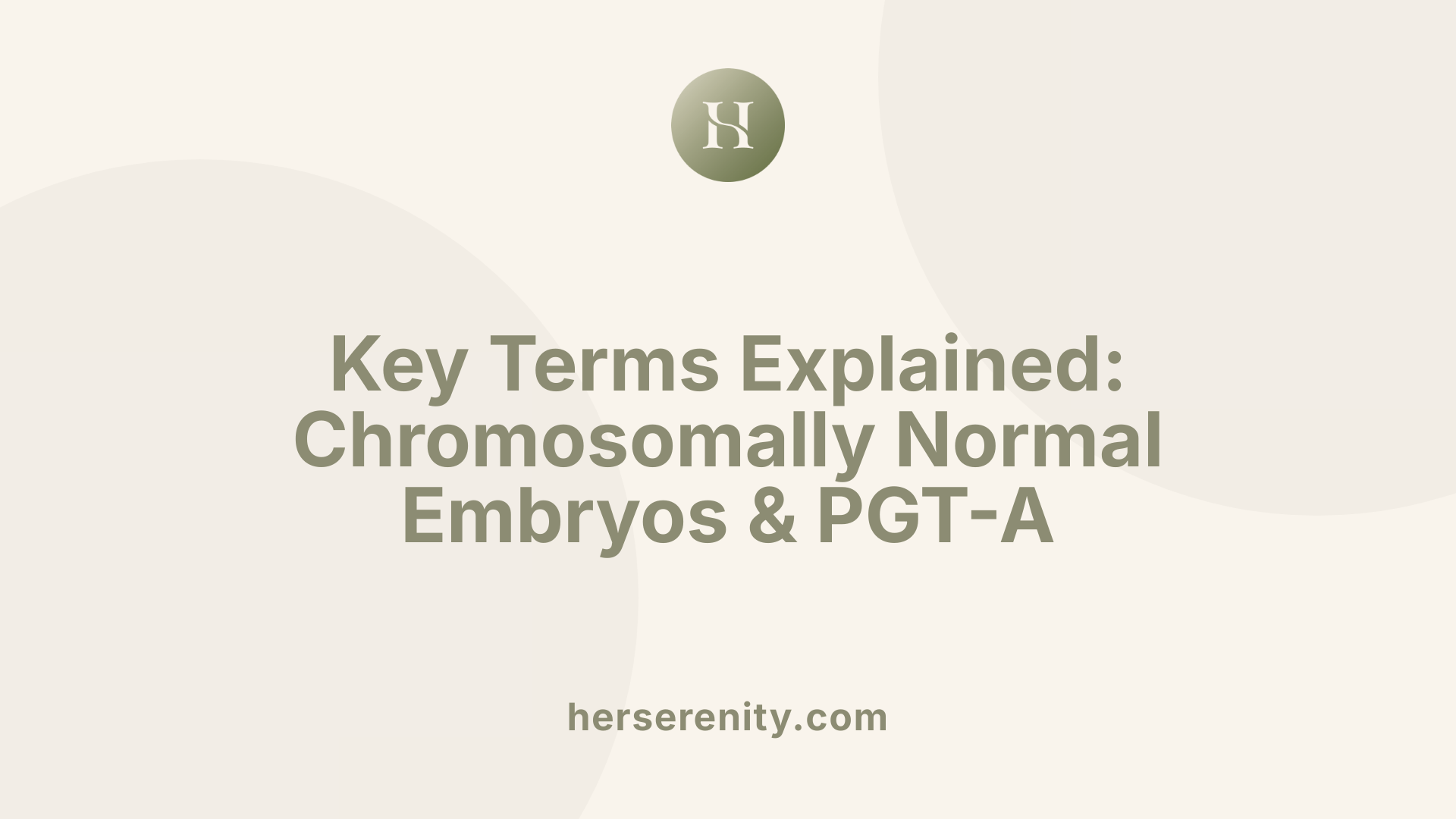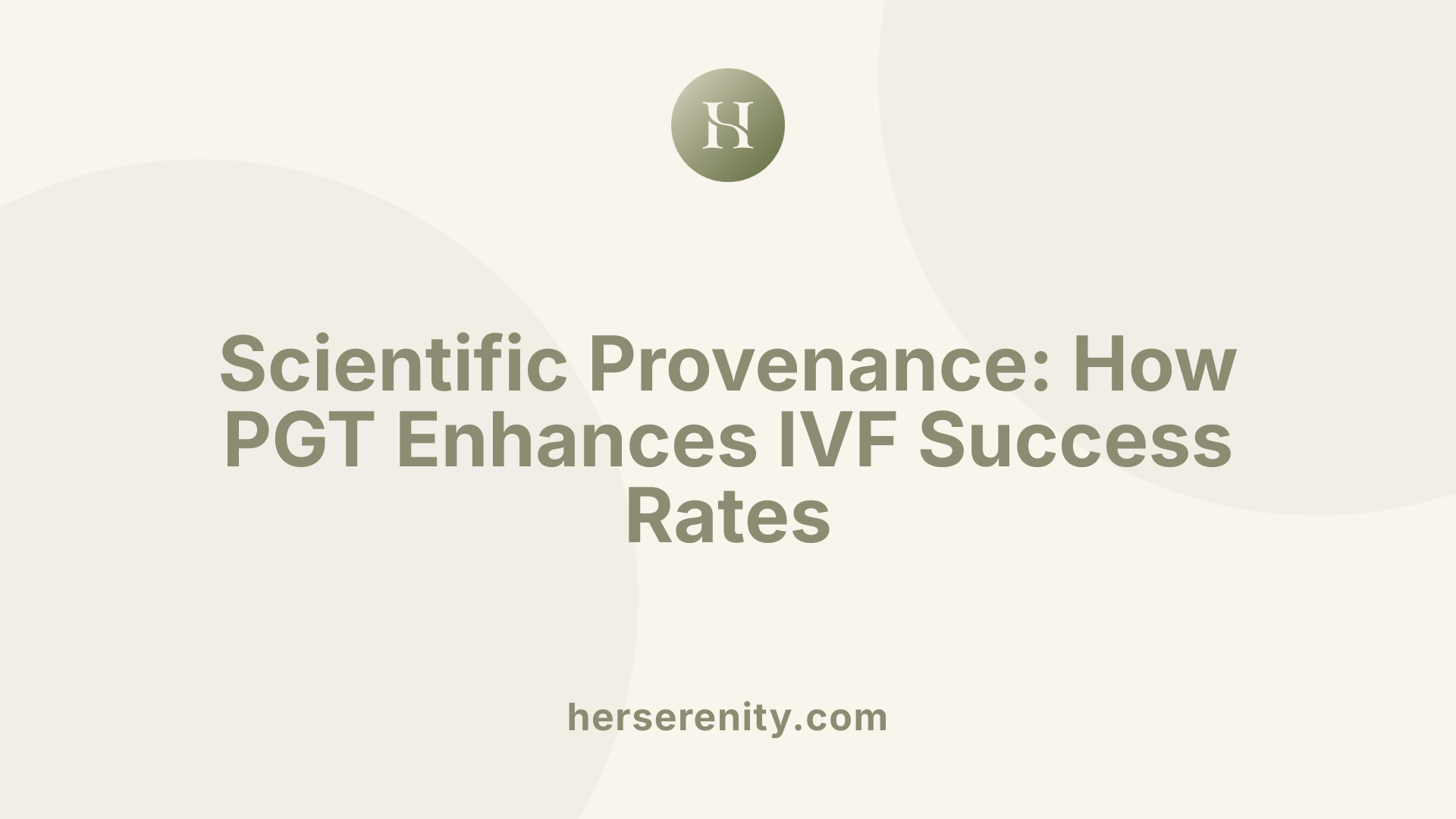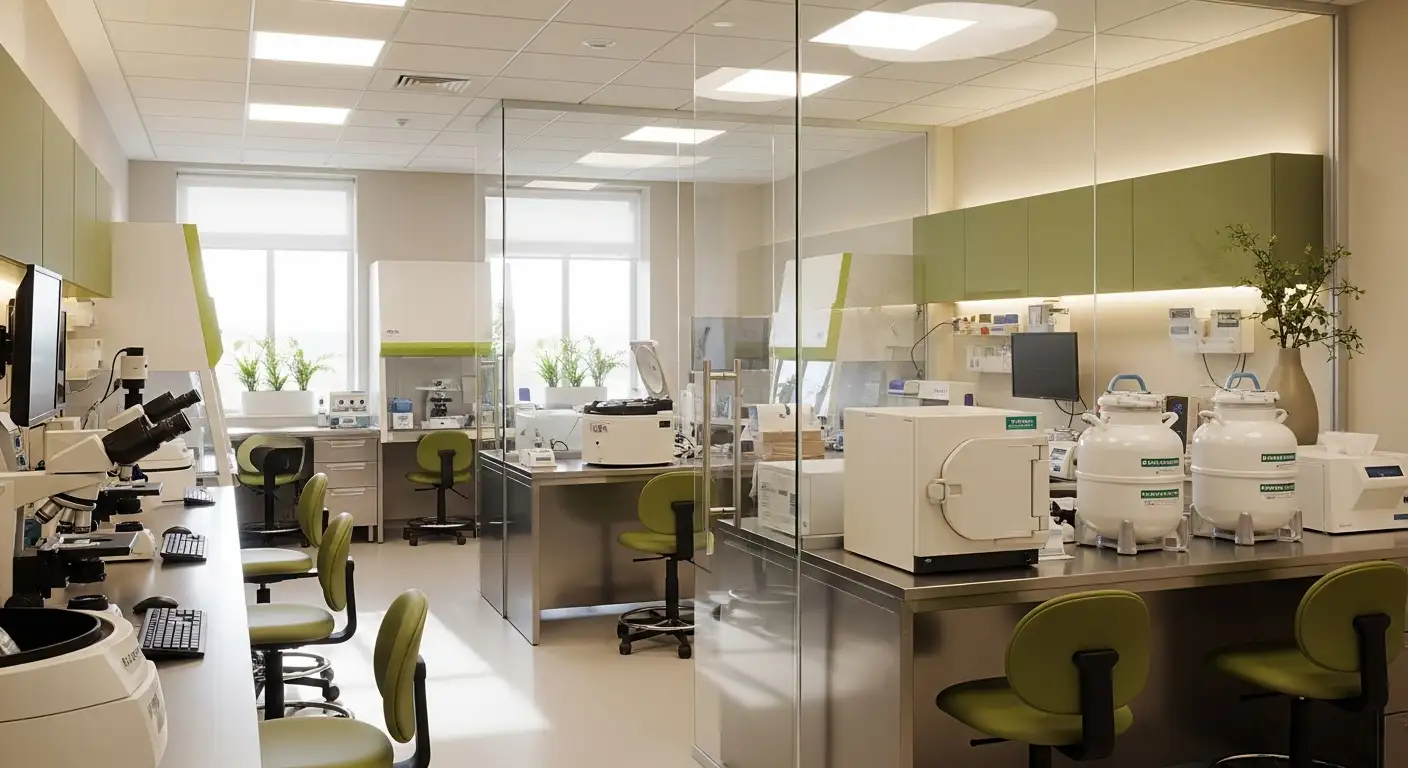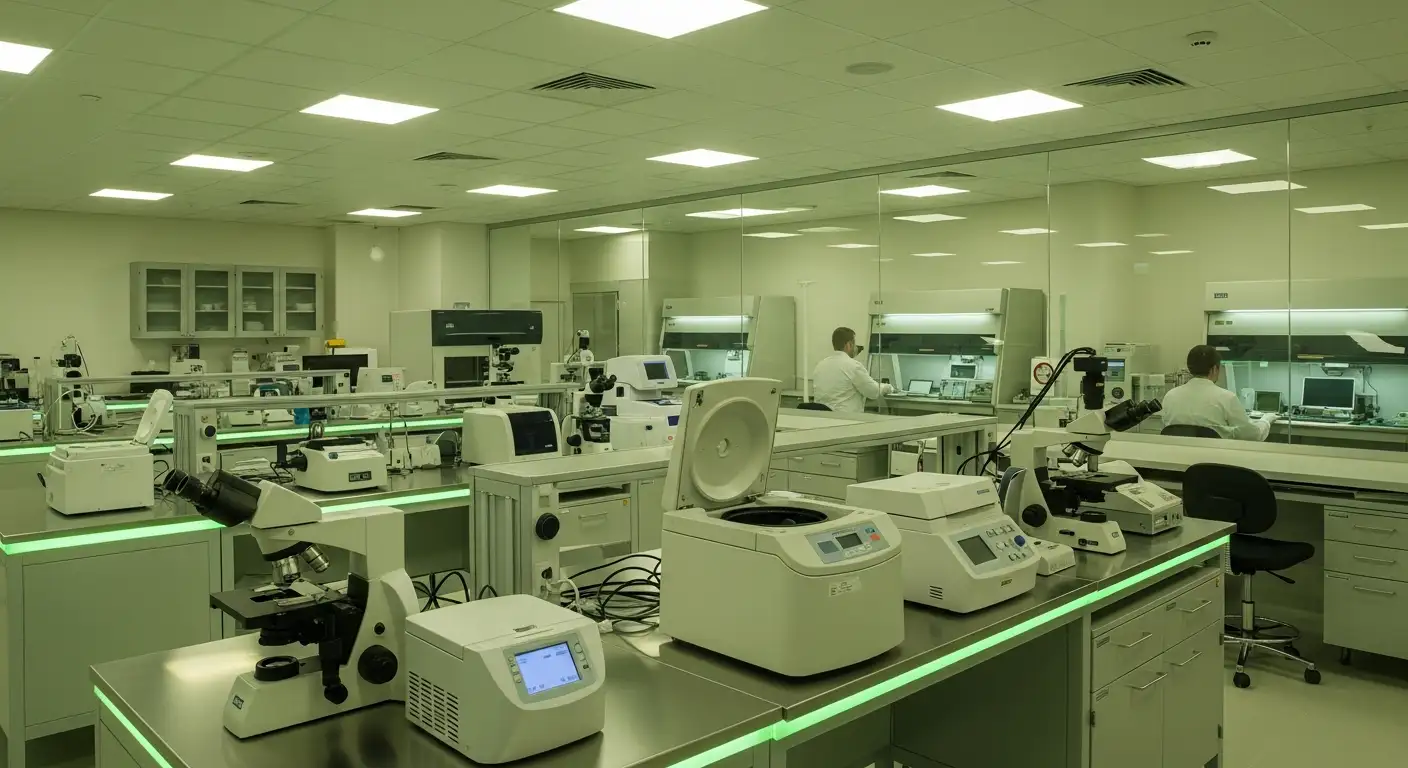What’s the success rate of PGT-tested embryos?
Unlocking the Potential of PGT in IVF Success

Understanding PGT and Its Impact on IVF Outcomes
Preimplantation Genetic Testing (PGT), especially PGT-A, has revolutionized in vitro fertilization (IVF) by enabling precise selection of embryos with the highest potential for successful pregnancy. This article explores what PGT-tested embryos are, how the testing process works, and the significant role they play in improving IVF success rates and reducing miscarriage risks.
What Are PGT-Tested Embryos and How Does the Testing Process Work?

What are PGT-tested embryos and how does the testing process work?
Preimplantation Genetic Testing (PGT) is a technique used during IVF to evaluate embryos for genetic abnormalities before they are implanted in the uterus. This process aims to identify the healthiest, chromosomally normal embryos, thereby increasing the likelihood of a successful pregnancy.
The process begins with the creation of multiple embryos in the laboratory through fertilization. When these embryos reach the blastocyst stage—typically on days 5 or 6—embryologists perform a biopsy. During this biopsy, a small sample of cells, usually between 5 to 10, is carefully removed from the embryo's outer layer, called the trophectoderm.
The harvested cells are then sent to a specialized genetic laboratory for analysis. Most often, next-generation sequencing (NGS) is employed, which provides detailed information on the embryo’s chromosomal makeup. This testing can reveal issues such as aneuploidy (extra or missing chromosomes), single-gene disorders, or structural rearrangements, depending on the specific type of PGT being conducted.
Results from the genetic tests generally take about 7 to 10 days. Embryos that are identified as genetically normal (euploid) are then frozen for future transfer, which improves success rates by allowing for the transfer of the most viable embryos. This approach not only enhances the chances of achieving pregnancy but also reduces the risk of miscarriage linked to genetic abnormalities.
While PGT significantly improves the selection process, it is not without limitations. There is a small risk of misdiagnosis or damage to the embryo during biopsy, and not all genetic issues can be detected. Nonetheless, PGT has proven to be a valuable tool in modern reproductive medicine, helping many couples achieve their goal of having a healthy baby.
Deciphering Key Terms: Chromosomally Normal Embryos and PGT-A

What do terms like chromosomally normal embryos and PGT-A mean?
In the context of in vitro fertilization (IVF), understanding certain terminologies can clarify how modern techniques are improving success chances. One important concept is that of "chromosomally normal embryos." These are embryos that have the correct number of chromosomes, generally 46, which is standard for humans. Ensuring chromosomal normalcy is crucial because abnormalities in chromosome number can lead to failed implantation, miscarriage, or genetic disorders.
Preimplantation Genetic Testing for Aneuploidy, commonly known as PGT-A, is a specialized screening process performed on embryos created during IVF. This test is designed to identify embryos with a normal or abnormal number of chromosomes. During PGT-A, a small number of cells—usually between 2 and 10—are biopsied from the embryo's outer layer (trophectoderm) at the blastocyst stage, typically on Day 5 or 6 of development.
Advanced genetic analysis tools, especially next-generation sequencing (NGS), are employed to examine these cells thoroughly. Embryos that are found to be chromosomally normal—referred to as euploid—are then prioritized for transfer, as they have a significantly higher likelihood of implanting successfully and resulting in a healthy pregnancy.
The benefits of identifying chromosomally normal embryos extend beyond higher implantation rates. They also substantially reduce the risk of miscarriage and genetic anomalies in the baby. Since a large percentage of miscarriages, especially in women of advanced maternal age, are related to chromosomal abnormalities, PGT-A acts as an effective method to improve overall IVF success.
In summary, terms like "chromosomally normal embryos" and PGT-A highlight the emphasis on genetic health within IVF procedures. Selecting embryos with a correct chromosome complement increases the probability of a successful pregnancy and a healthy birth, making them vital tools in modern fertility treatments.
Enhancing IVF Outcomes and Minimizing Risks with PGT

How does PGT help improve IVF success rates and reduce miscarriage risk?
Preimplantation genetic testing for aneuploidy (PGT-A) plays a pivotal role in boosting IVF success. By examining embryos for chromosomal abnormalities before transfer, PGT-A allows fertility specialists to select embryos that are chromosomally normal, known as euploid embryos. This targeted selection significantly increases the chances of successful implantation and live birth.
Statistics show that embryos tested with PGT-A demonstrate higher viability. For instance, a 2018 study involving over 1,800 IVF cycles with SNP-based PGT-A reported an implantation rate of nearly 70%, and a live birth rate per transfer of approximately 65%. Additionally, the live birth rate for euploid embryos was consistently high, around 70%, whether using donor eggs or the patient's own eggs, as shown in 2022 studies.
One of the most critical benefits of PGT-A is its ability to reduce miscarriage rates. Chromosomal abnormalities are a leading cause of early pregnancy loss. By identifying and transferring only chromosomally normal embryos, PGT-A significantly decreases the risk of miscarriage. This is especially beneficial for women of advanced maternal age, who are more likely to produce embryos with chromosomal issues.
Recent large-scale analyses of over 56,000 retrieval cycles reveal that the impact of PGT-A varies with maternal age. For women under 35, PGT-A slightly lowers the cumulative live birth rate (risk ratio 0.96), possibly due to the exclusion of some embryos. However, for women aged 35 and above, PGT-A markedly improves outcomes, with risk ratios of 1.04 in 35-37-year-olds and 1.14 in 38-40-year-olds. This indicates a significant benefit in older age groups, who are more prone to chromosomal abnormalities.
Further, studies focusing on freeze-all cycles—where all embryos are frozen for later transfer—highlight that PGT-A enhances live birth rates in women over 35. Moreover, miscarriage rates are notably lower in women aged 35 and above when PGT-A is used.
Supporting this, research from the Colorado Center for Reproductive Medicine found that women aged 38-42 had similar live birth rates to those 37 or younger when they transferred chromosomally normal embryos identified through PGS. The chromosomal error rate in women over 38 is considerably higher, approximately 62%, compared to 37% in women under 38, confirming the advantage of genetic testing in older women.
In practice, PGT involves biopsying 2-10 cells from the trophectoderm of a blastocyst, which are then analyzed for chromosomal normalcy using advanced techniques like next-generation sequencing (NGS). This process enhances the precision of embryo selection, leading to better pregnancy outcomes.
How does embryo grading contribute to success?
In addition to genetic testing, embryologists assess embryo quality through grading systems, such as the Gardner system. This evaluation considers cell number, fragmentation, and development stage on Day 3 and Day 5 post-fertilization. Higher-grade embryos, characterized as A, B, or C based on internal cell mass and trophectoderm quality, are associated with higher implantation and pregnancy rates.
A 2023 study in the US National Library of Medicine confirmed that higher embryo grades predict better clinical pregnancy and live birth outcomes. Moreover, expanded blastocysts—those with more advanced development—are twice as likely to result in pregnancy as earlier-stage blastocysts. However, maternal factors, embryo quality, and genetic status collectively influence success rates.
How do fertility clinics achieve high success rates?
Leading clinics like the Colorado Center for Reproductive Medicine have demonstrated exceptional success with frozen embryo transfer (FET) cycles, especially when using PGT. Their success across different age groups, documented in data from the Society for Assisted Reproductive Technology (SART), indicates that combining embryo grading with genetic testing optimizes outcomes.
Overall, the integration of PGT-A, embryo grading, and refined laboratory protocols has revolutionized IVF. These advancements allow for personalized treatment, higher success rates, and healthier pregnancies, particularly for women at higher reproductive risk due to age or genetic concerns.
| Aspect | Effect | Supporting Data | Notes |
|---|---|---|---|
| IVF success rate with PGT-A | Increases by approximately 10-20% | 2018 study, NGS results | Includes implantation, pregnancy, and live birth rates |
| Live birth rate in different ages | ~70% for euploid embryos | 2022 study, donor and self eggs | Varies slightly by age and embryo quality |
| Miscarriage reduction | Significant decrease, especially over age 35 | Large cycle analysis | Reflects fewer chromosomal errors |
| Embryo grading importance | Higher grades relate to better outcomes | 2023 research | Grading assesses morphology, development |
| Success in frozen embryo transfers | Consistently high across clinics | CCRM and SART data | Optimized with PGT and embryo quality assessment |
By combining genetic testing with careful embryo assessment, fertility treatments are becoming more precise and successful. These advancements provide hope and improved chances for individuals seeking to build their families through IVF.
Statistical Success Rates of PGT-Tested Embryos
What are the statistical success rates and live birth outcomes associated with PGT-tested embryos?
Recent studies highlight that embryos tested with Preimplantation Genetic Testing for Aneuploidy (PGT-A) tend to produce higher live birth rates per transfer. Typically, these rates range from about 50% to 70%, with some specific populations seeing rates as high as 77.2%. For instance, a large-scale analysis of over 56,000 IVF cycles reported that most cycles did not use PGT-A (88%), but among those that did, particularly in older women aged 35 and above, success rates improved notably.
In cases where a euploid embryo – an embryo with a normal number of chromosomes – was transferred, the live birth rate reached around 70%. This is especially significant because PGT-A enhances the chance of selecting such euploid embryos, thereby increasing the likelihood of successful implantation and subsequent birth.
Frozen embryo transfer (FET) cycles that utilized PGT-A have demonstrated even higher success rates compared to fresh transfers. The consistency in outcomes underlines the benefit of embryo cryopreservation in conjunction with genetic testing. Overall, data from large patient populations consistently show that live birth rates are elevated when PGT-A is used, particularly as women age.
How does PGT influence success rates across different age groups?
Age remains a crucial factor in IVF success, but PGT-A appears to mitigate some of the age-related decline. A significant study analyzed the cumulative live birth rates after PGT with next-generation sequencing among women aged 21-40 years undergoing single blastocyst transfer.
Results indicated that for women aged 35-37, PGT was associated with a 4% increase in cumulative live birth rate (risk ratio 1.04), whereas for women aged 38-40, the increase was more pronounced at 14% (risk ratio 1.14). For younger women under 35, PGT-A showed a slight reduction in the live birth rate, possibly due to other factors influencing outcomes.
Furthermore, in a subgroup of freeze-all cycles, PGT-A’s benefit was even more evident in women aged 35 and above, with significantly lower miscarriage rates seen among these patients. The data suggest that employing PGT-A in women of advanced maternal age helps select chromosomally normal embryos, thereby boosting live births and reducing pregnancy losses.
How successful are PGT-tested embryos in different scenarios?
The Colorado Center for Reproductive Medicine conducted a pivotal study on women aged 38-42, revealing that their live birth rate was comparable to women 37 or younger when transferring chromosomally normal embryos. This underscores the importance of genetic testing in offsetting the effects of age-related chromosomal errors.
While women under 38 had a chromosomal error rate of approximately 37%, women aged 38-42 faced a much higher rate of about 62%. Despite these differences, when using PGT to select chromosomally normal embryos, live birth rates were around 60% for women aged 38-42, closely matching the 64% rate of younger women.
How does embryo quality impact success, and what is the role of embryo grading?
Embryo grading, which assesses development quality based on morphology and other factors, plays a vital role alongside genetic testing. Most embryologists use standardized grading systems such as the Gardner scale, which considers cell number, degree of expansion, and quality of the inner cell mass and trophectoderm.
Higher graded embryos, such as those rated A, B, or C, tend to have significantly higher chances of implantation and live birth. For instance, expanded blastocysts are twice as likely to result in pregnancy as earlier-stage blastocysts. However, even lower-graded embryos can result in healthy pregnancies, especially when combined with PGT-A results.
Summaries of success rates across age and embryo quality
| Age Group | Live Birth Rate (Approx.) | Chromosomal Error Rate | Importance of PGT-A | Reproductive Strategy |
|---|---|---|---|---|
| Women <35 | 64-70% | 37% | High | Embryo grading + PGT-A |
| Women 35-37 | ~70% | 37-62% | Very high | PGT-A improves outcomes |
| Women 38-42 | 60-64% | 62% | Critical | Use of chromosomally normal embryos |
Overall Impact of PGT on IVF Success
The integration of PGT-A into IVF cycles has markedly improved the chances of successful pregnancies and live births, especially for women of advanced age. By selecting chromosomally normal embryos, patients benefit from higher implantation rates, reduced miscarriage risks, and more predictable outcomes.
Data from reputable clinics like CCRM reinforce these findings, with their programs demonstrating exceptional success rates across all age groups and using frozen embryo transfer strategies. This collective evidence underscores that PGT-A is a valuable tool in modern reproductive medicine, contributing to higher success rates and healthier pregnancies.
Influencing Factors on Embryo Transfer Success
What factors influence the success rate of pregnancies using PGT-tested embryos?
The success of pregnancies involving PGT (Preimplantation Genetic Testing) tested embryos depends on several interrelated factors. These elements can increase the chances of implanting a healthy embryo and achieving a live birth.
Maternal age plays a crucial role. Younger women typically experience higher success rates in IVF cycles. Studies have shown that, when using genetically tested embryos, women under 35 have very high success rates, although the overall trends improve across age groups with the use of PGT.
Embryo quality and grading are also important. Embryologists evaluate embryos using grading systems, such as the Gardner system, which assesses parameters like cell number, fragmentation, and development stage up to Day 3 or Day 5 (blastocyst stage). Embryos with higher grades—often denoted as A, B, or C based on assessments of the inner cell mass and trophectoderm—usually have better chances of successful implantation.
Success rates tend to double with higher-grade embryos, especially when expanding to blastocyst stage. However, even lower-graded embryos can sometimes result in healthy pregnancies.
Uterine environment factors are equally crucial. The health and receptivity of the endometrial lining influence implantation success. Proper timing and synchronization between the embryo development stage and the uterine environment contribute significantly to pregnancy outcomes.
Genetic testing methods such as PGT-A (for aneuploidy screening) and PGT-M (for specific genetic diseases) add another layer of influence. PGT helps identify chromosomally normal (euploid) embryos, which are more likely to implant and carry pregnancy to term. Studies report live birth rates of approximately 70% when transferring euploid embryos, regardless of maternal age.
Laboratory practices and embryo assessment techniques further impact success. This includes the quality of genetic testing, embryo biopsy procedures, and cryopreservation methods such as vitrification. High-quality laboratory environments, like those maintained by leading clinics such as CCRM, contribute to higher success rates.
Individual health factors such as underlying fertility issues, lifestyle, weight, and overall health also influence outcomes. Addressing these aspects improves the chances of success in embryo transfer procedures.
A comprehensive understanding of these factors allows clinics and patients to optimize their chances of success during IVF treatments involving PGT testing.
| Factor | Impact | Additional Notes |
|---|---|---|
| Maternal Age | Higher age correlates with lower success | Younger women generally succeed more; PGT can mitigate age-related decline |
| Embryo Quality | Higher grades increase success | Embryo grading assesses developmental stage and morphology |
| Uterine Environment | Critical for implantation | Receptivity and synchronization are vital |
| Genetic Testing Method | Identifies viable embryos | PGT-A and PGT-M improve embryo selection |
| Laboratory Practices | Enhances embryo viability | Vitrification and biopsy quality influence outcomes |
| Overall Health | Optimizes condition for pregnancy | Lifestyle modifications can improve success |
In practical terms, combining high-quality embryo grading, genetic testing for chromosomal normalcy, and ensuring a receptive uterine environment significantly improves the likelihood of a successful pregnancy.
How does embryo grading and genetic testing complement each other?
Embryo grading provides an initial assessment of embryo morphology and development, helping to select candidates for transfer or further testing. Meanwhile, genetic testing adds a biological insight into the embryo’s chromosomal makeup.
Recent studies emphasize that higher-grade embryos tend to have better implantation and live birth outcomes. However, genetic testing ensures that only embryos with the correct chromosome number are transferred, reducing miscarriage risks associated with genetic abnormalities.
This combined approach offers a robust strategy, especially for women of advanced maternal age, where the rate of chromosomal errors (about 62% in women aged 38-42) is notably higher. By selecting chromosomally normal embryos, success rates improve, even when embryo morphology is less than perfect.
The overall goal is to maximize embryo health, viability, and compatibility with the uterine environment to enhance success in IVF cycles.
Comparison of PGT Success With Other Testing and Selection Methods
How does PGT success compare with other embryo selection or testing methods?
Preimplantation genetic testing (PGT), especially PGT-A, is a procedure that involves analyzing the chromosomes of embryos to select those that are chromosomally normal. This genetic analysis adds a layer of precision over traditional methods like embryo morphology grading.
Morphology assessment involves evaluating the appearance and developmental stage of embryos to determine their quality. Embryologists look at factors such as cell number, fragmentation, and embryo expansion, often using grading systems like Gardner's to gauge the likelihood of implantation.
Research shows that PGT-A can improve outcomes by selecting embryos with the correct number of chromosomes, which tend to have higher implantation rates and lower miscarriage risks. For example, the 2018 study reported that SNP-based PGT-A resulted in a clinical pregnancy rate of about 70.6% per transfer, with live births at 64.5%. Similarly, a 2022 study highlighted that the live birth rate per euploid embryo (a genetically normal embryo) was over 70%, highlighting the effectiveness of genetic testing.
However, recent findings suggest that in women with good prognosis—those with multiple high-quality blastocysts—adding PGT-A doesn't significantly boost live birth rates compared to conventional IVF. In some cases, it may even lead to slightly reduced cumulative success. For patients with advanced maternal age, PGT can reduce miscarriage rates substantially. This benefit is especially notable in women over 35, where PGT has been linked to a measurable increase in live births and decreased pregnancy losses.
While embryo grading remains an accessible and rapid method for initial screening, it does not identify chromosomal health. PGT complements this approach by providing detailed genetic insights that can improve embryo selection accuracy.
It’s essential to understand that the choice between morphological assessment and genetic testing depends heavily on individual circumstances. For women with fewer embryos or known genetic concerns, PGT offers a more targeted approach. Conversely, for those with abundant high-quality embryos, traditional grading may suffice.
In summary, PGT, especially PGT-A, generally enhances the chances of successful pregnancy by selecting chromosomally normal embryos. Still, its benefit over morphology-based assessment varies according to patient age, ovarian reserve, and previous IVF success. While genetic testing adds valuable information, it is not a replacement for embryo grading but rather a complement that can refine embryo selection for better outcomes.
Scientific Evidence Supporting PGT Effectiveness

What scientific evidence supports the effectiveness of PGT in IVF treatments?
Preimplantation Genetic Testing (PGT), especially with advanced techniques like PGT-A and next-generation sequencing (NGS), has substantially improved the outcomes of IVF treatments. Numerous studies have demonstrated that PGT enables the identification of chromosomally normal (euploid) embryos before transfer. This selection process significantly reduces the likelihood of transferring abnormal embryos that often result in miscarriage or failed implantation.
A comprehensive 2018 study analyzing over 1,800 IVF cycles using SNP-based PGT-A reported that the implantation rate was approximately 70%, with a clinical pregnancy rate per transfer of about 71%, and a live birth rate per transfer of 65%. Such data reflect the enhanced success rates achievable by screening embryos for chromosomal normalcy. These improvements are especially notable in women of advanced maternal age, where chromosomal abnormalities are more prevalent.
Further research from 2022 revealed that the live birth rate per euploid embryo was around 70% for both women using donor eggs and those using their own eggs. This consistency highlights PGT’s ability to optimize outcomes regardless of maternal age, by selecting embryos with the highest likelihood of successful pregnancy.
Long-term safety is another critical aspect supported by evidence. Children born after PGT have shown health outcomes comparable to natural conception, with no increase in birth defects or developmental issues. This indicates that the biopsy process, performed on a small number of cells from the blastocyst, does not negatively impact embryo viability.
Advancements like NGS have improved the accuracy and reliability of PGT. These technologies allow for detailed analysis of all chromosomes simultaneously, reducing false positives and negatives. Meta-analyses of numerous studies further confirm that PGT-A results in higher euploidy rates, shorter time to pregnancy, and a reduction in miscarriage rates, particularly in older women.
Additionally, large cohort studies and registry data reinforce that embryo selection through PGT leads to more efficient IVF cycles with higher success rates. For instance, an extensive analysis of 56,469 cycles showed that the use of PGT-A was associated with increased cumulative live birth rates for women aged 35 and above, notably in freeze-all cycle subgroups.
How do recent advancements contribute to the credibility of PGT?
Recent technological improvements, like the shift to NGS, have increased the precision of detecting chromosomal abnormalities. Accurate embryo screening helps clinicians select the best embryo for transfer, minimizing the risk of miscarriage and increasing chances of live birth.
In summary, a combination of clinical research, technological progress, and long-term safety data supports the strong efficacy of PGT in improving IVF outcomes. Patients benefit from higher chances of pregnancy, reduced miscarriage risks, and healthier births, especially as maternal age advances, making PGT a cornerstone in modern reproductive medicine.
Role of Embryo Grading Versus Genetic Testing
Embryo grading system
In IVF, embryo grading plays a vital role in evaluating the quality of developing embryos. This process involves assessing the embryos at specific developmental stages, typically on Day 3 and Day 5 after fertilization, using a standardized grading system such as the Gardner system. Embryologists examine factors such as cell number, degree of fragmentation, and the morphology of the inner cell mass and trophectoderm. These parameters help determine the potential of an embryo to implant successfully.
Higher graded embryos, such as those rated with A, B, or C, generally exhibit better prospects for a successful pregnancy. Among these, expanded blastocysts—embryos that have undergone significant development and expansion—are twice as likely to lead to clinical pregnancies compared to earlier-stage embryos. Despite the predictive value of grading, it is not definitive on its own. A lower-grade embryo can still result in a healthy pregnancy, emphasizing the importance of considering additional information.
Complementary nature of testing methods
While embryo grading provides valuable morphological insights, it is complemented by genetic testing techniques like Preimplantation Genetic Testing for Aneuploidy (PGT-A). PGT-A involves biopsying 2-10 cells from the trophectoderm of a blastocyst to analyze its chromosomal composition. This process detects chromosomal abnormalities that could impair implantation or lead to miscarriage.
Genetic testing enhances success rates by allowing clinicians to select embryos free of chromosomal errors, thereby increasing the likelihood of implantation and a successful pregnancy. It also reduces the risk of miscarriage related to chromosomal abnormalities, particularly in women of advanced maternal age, who tend to have higher error rates. Ultimately, while embryo grading assesses developmental quality, PGT-A evaluates genetic health, making both methods valuable for comprehensive embryo assessment.
Impact on selection and success
Research indicates that genetically testing embryos significantly influences IVF outcomes. A 2018 study involving over 1,800 cycles using SNP-based PGT-A reported an implantation rate of approximately 70%, with live birth rates per transfer around 65%. More recent data from 2022 highlight that live birth rates with chromosomally normal (euploid) embryos are around 70% for both donor and patient eggs.
Embryo selection through combined grading and genetic testing improves overall success. For example, high-grade blastocysts with confirmed chromosomal normalcy have demonstrated increased implantation and live birth rates. Furthermore, a large-scale analysis of thousands of cycles revealed that while embryo grading alone can predict success, the addition of PGT-A markedly enhances outcomes, especially in women aged 35 and older.
A particular advantage of these combined methods is the reduction in miscarriage rates, mainly in women over the age of 35. A subgroup analysis of freeze-all cycles showed that PGT-A contributed to higher cumulative live birth rates and lower miscarriage rates, with women aged ≥35 experiencing the most benefit.
Table: Summary of Embryo Evaluation Methods
| Method | How it Works | Key Benefits | Limitations |
|---|---|---|---|
| Embryo grading | Morphological assessment on Day 3 and Day 5 | Simplicity, quick, standard | Less predictive for genetic health |
| PGT-A | Biopsy of trophectoderm cells, genetic analysis | Accurate chromosomal status, higher success | More invasive, costly |
| Combined approach | Morphological + genetic assessment | Improved selection, success, and reduced miscarriages | Requires technical expertise |
Role in IVF success rates across age groups
Success rates for IVF using embryo grading and genetic testing remain relatively stable when measured per transfer, regardless of maternal age. However, overall success declines with age when considering the entire cycle, mostly because older women tend to produce fewer high-quality, chromosomally normal embryos.
For women aged under 35, data sometimes show that PGT-A may slightly lower cumulative live birth rates, potentially due to over-restriction of available embryos. Conversely, for women aged 35-37 and especially 38-40, PGT-A is associated with increased live birth rates, mainly by selecting the most viable embryos and reducing miscarriage risks.
Embryo quality and success probabilities
A 2023 study published in the US National Library of Medicine highlighted that higher embryo grades correlate with better pregnancy and live birth outcomes. Successful transfers of chromosomally normal embryos have progressively better odds, especially when the embryo is an expanded blastocyst.
In conclusion, combining embryo grading with genetic testing offers a comprehensive strategy for embryo selection, improving the chances of successful IVF outcomes across different age groups. This integrated approach helps clinicians and patients make more informed decisions, optimizing the path toward a healthy pregnancy.
CCRM's Success Rates and Data Transparency
What are the success rates based on SART data?
The Colorado Center for Reproductive Medicine (CCRM) is renowned for its high success rates in IVF treatments, and these rates are consistently monitored and reported based on data from the Society for Assisted Reproductive Technology (SART). These reports provide a detailed overview of outcomes for women of different age groups who undergo IVF, especially with the utilization of PGT-A (Preimplantation Genetic Testing for Aneuploidy).
From 2007 to 2023, CCRM has documented their live birth rates for PGT with frozen embryo transfer (FET) cycles, showing impressive consistency and success. Overall, their data indicate that success rates are high across all ages, with particularly strong outcomes in young women and those using their own genetic material. For example, in women under 35, success rates often exceed 70%, whereas in women aged 38-42, live birth rates from PGT-A tested frozen embryos typically hover around 60-65%.
These figures are based on thousands of cycles each year—CCRM analyzed data from over 56,000 retrieval cycles across multiple centers—and reflect the effectiveness of combining embryo genetic testing with advanced embryo cryopreservation techniques.
Achievements in frozen embryo transfer
CCRM has demonstrated exceptional results with frozen embryo transfers, especially when embryos are chromosomally normal as determined by PGT-A. Their success rates for FET cycles are among the highest in the industry and have been consistently reported across all age categories. For women of advanced maternal age, notably those 38-42, success rates reach approximately 60-65% per transfer.
These high success outcomes are partly due to the ability to select only chromosomally normal embryos for transfer. As a result, CCRM reports significantly reduced miscarriage rates and increased live births, especially in women over 35.
The clinic's focus on freezing embryos at the blastocyst stage (Day 5 embryo) has also contributed to improved results, allowing better embryo selection through grading and genetic testing before transfer.
Data collection and transparency
CCRM prides itself on transparency and relies on SART’s comprehensive reporting standards to benchmark their success. These data include detailed success rates by age, type of cycle (fresh or frozen), and utilization of genetic testing.
Their consistent high performance across various parameters underscores their ability to achieve successful pregnancies, even in challenging cases involving advanced maternal age or previous fertility issues.
| Age Group | Live Birth Rate from PGT-A FET | Success Rate Trend | Comments |
|---|---|---|---|
| Under 35 | Over 70% | Consistently high | Preferred age group with greatest success |
| 35-37 | Slightly above 70% | Stable | Improved outcomes with PGT-A |
| 38-42 | Around 60-65% | Increasing | Assisted by advanced embryo selection |
Final thoughts
CCRM’s detailed data from SART emphasizes a significant trend: that genetic testing combined with cryopreservation techniques yields high success rates across different patient profiles. The focus on embryo quality, rigorous testing, and reliable data credibility makes CCRM a leading choice for individuals seeking high chances of successful pregnancy outcomes through IVF.
Maximizing IVF Success with PGT — What Patients Need to Know
In conclusion, PGT-testing of embryos has become a cornerstone in modern IVF treatment, significantly improving implantation, pregnancy, and live birth rates, especially in women of advanced maternal age or with previous pregnancy losses. The success rate of PGT-tested embryos can reach as high as 70% per euploid embryo transfer, with reduced miscarriage risks. While embryo grading remains an essential tool for assessing embryo quality, genetic testing provides a crucial layer of insight, allowing for more precise embryo selection. The ongoing refinement of genetic analysis techniques and accumulating scientific evidence continue to support PGT as a vital intervention for achieving successful outcomes in assisted reproduction. Patients considering IVF should consult with their fertility specialists to understand how PGT can maximize their chances of a healthy pregnancy.
References
- IVF With Genetic Testing (PGT): Benefits and Success Rates
- Success rates with preimplantation genetic testing for ...
- How PGS can Improve Success Rates with Chromosomally ...
- IVF Embryo Grading and Success Rates, Explained by An ...
- Fertility Success Rates - IVF, IUI, & More
- The impact of preimplantation genetic testing for ...
- The impact of preimplantation genetic testing for ...


































































































